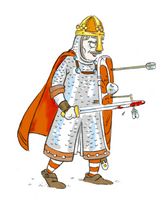William the Conqueror of Normandy and England
William (c. AD 1027-1087) was the son of Robert I of Normandy and great-great-great-grandson of the Viking chieftain Rollo who, by way of an attack on France in AD 911, and subsequent peace negotiations, became Duke of Northern France.
After innumerable power struggles between the French Counties, William himself became Duke of Normandy in AD 1046.
The Anglo-Saxon Chronicle mentions, in a very few lines, that William visited Edward the Confessor in England in AD 1051:
Earl William came from beyond the sea with a great company of Frenchmen and the King received him and as many of his companions as he thought appropriate and then he let him depart again.
It must have been during this visit that Edward, as William later maintained, promised him the English throne. As the latter was given instead to Harold Godwinson on Edward's death in AD 1066, William declared war on the new king. The Bayeux Tapestry shows how William arrived in Southern England on 28th September with a great fleet and almost 7000 men. On 14th October the Norman army met the English troops at the Battle of Hastings, where Harold Godwinson was killed and William began his conquest of England.
In the subsequent months, William plundered and burned a number of towns in Southern England and took over control. For this reason he was given the byname “the Conqueror”. On Christmas Day of that same year, William was crowned king in Westminster Abbey in London. He remained on the throne until his death in AD 1087.
William's half-brother Odo was the bishop in Bayeux. The church here was consecrated in AD 1077 and several sources are of the opinion that the Bayeux Tapestry, which describes the Battle of Hastings and William’s conquest of England, was made specifically for the building.
Louise Kæmpe Henriksen
